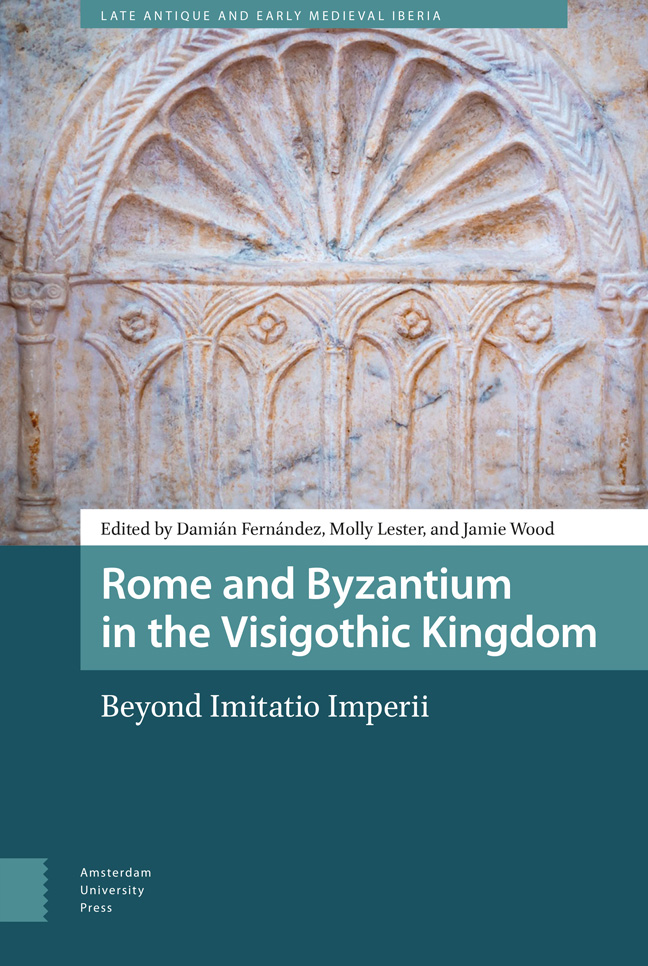Book contents
- Frontmatter
- Contents
- List of Figures and Tables
- Abbreviations
- Acknowledgements
- Maps
- Introduction
- 1 Visigothic Spain and Byzantium: The Story of a Special (Historiographical) Relationship
- 2 The Development of the Visigothic Court in the Hagiography of the Fifth and Sixth Centuries
- 3 Experiments in Visigothic Rulership: Minting and Monetary Reforms under Alaric II
- 4 A Comparison of Roman and Visigothic Approaches to Exile
- 5 The Roman Jewel in the Visigothic Crown: A Reassessment of the Royal Votive Crowns of the Guarrazar Treasure
- 6 Capitalhood in the Visigothic Kingdom
- 7 Making Rite Choices: Roman and Eastern Liturgies in Early Medieval Iberia
- 8 Ethnicity and Imitatio in Isidore of Seville
- 9 Re-imagining Roman Persecution in the Visigothic Passions
- 10 Romanness in Visigothic Hagiography
- 11 Empire and the Politics of Faction: Mérida and Toledo Revisited
- 12 The Agents and Mechanics of Connectivity: The Mediterranean World and the Cities of the Guadiana Valley in the Sixth Century
- 13 Staying Roman after 711?
- Index
5 - The Roman Jewel in the Visigothic Crown: A Reassessment of the Royal Votive Crowns of the Guarrazar Treasure
Published online by Cambridge University Press: 20 February 2024
- Frontmatter
- Contents
- List of Figures and Tables
- Abbreviations
- Acknowledgements
- Maps
- Introduction
- 1 Visigothic Spain and Byzantium: The Story of a Special (Historiographical) Relationship
- 2 The Development of the Visigothic Court in the Hagiography of the Fifth and Sixth Centuries
- 3 Experiments in Visigothic Rulership: Minting and Monetary Reforms under Alaric II
- 4 A Comparison of Roman and Visigothic Approaches to Exile
- 5 The Roman Jewel in the Visigothic Crown: A Reassessment of the Royal Votive Crowns of the Guarrazar Treasure
- 6 Capitalhood in the Visigothic Kingdom
- 7 Making Rite Choices: Roman and Eastern Liturgies in Early Medieval Iberia
- 8 Ethnicity and Imitatio in Isidore of Seville
- 9 Re-imagining Roman Persecution in the Visigothic Passions
- 10 Romanness in Visigothic Hagiography
- 11 Empire and the Politics of Faction: Mérida and Toledo Revisited
- 12 The Agents and Mechanics of Connectivity: The Mediterranean World and the Cities of the Guadiana Valley in the Sixth Century
- 13 Staying Roman after 711?
- Index
Summary
Abstract
Since its discovery in the mid-nineteenth century, the celebrated Guarrazar treasure has served as a touchstone for questions about the cultural orientation and prestige policy of the Visigothic kingdom of Toledo. Traditionally, the sumptuous votive crowns and crosses of the treasure have been understood to exhibit the ‘influence’ of Byzantium. But by looking closely at select elements from the treasure that we describe as ‘Roman’ or ‘Byzantine’, this chapter pressures straightforward assumptions of Byzantine influence. In disentangling the Roman from the Byzantine, the chapter argues that the presence of a Roman cross on the votive crown of a Visigothic king complicates narratives of translatio imperii in compelling ways, suggesting instead a more nuanced material sense of supersession.
Keywords: Guarrazar treasure; crowns; crosses; Byzantine influence; supersession
In August of 1858, a remarkable cache of early medieval gold crowns and crosses was discovered in Huertas de Guarrazar near Toledo. The fragments were immediately reassembled, found their way into private hands, and within just a few months most were sold to the French government. The acquisition was announced in Le Monde illustré on 12 February 1859 along with a brief description and illustration, and published more fully by Ferdinand de Lasteyrie in 1860 with a series of detailed colour engravings. The frontispiece of the publication featured this sumptuous ensemble and centred on the largest and most ornate of the crowns, that of the seventhcentury Visigothic king Recceswinth (r. 653–672), whose name is spelled out in Latin letters dangling from its lower edge. (See Figure 5.1.)
Meanwhile in Spain, diplomatic efforts were underway to repatriate the works. Since the initial announcement of the French acquisition, the Spanish government made valiant efforts to nullify the sale and have the pieces returned. In addition, excavations were carried out at the original site of the discovery. Led by José Amador de los Ríos, four further crowns were unearthed, including one naming another Visigothic king, Swinthila (r. 621–631), which was later stolen and has never been recovered. (See Figure 5.4.) In 1940 leaders of Spain and France ‘agreed to an exchange of national treasures’. Along with a Murillo painting of the Inmaculada (1678), the ancient Iberian sculpture known as La Dama de Elche, and archives from Salamanca, most, but not all, of the pieces of the Visigothic treasure were returned to Spain.
- Type
- Chapter
- Information
- Rome and Byzantium in the Visigothic KingdomBeyond Imitatio Imperii, pp. 123 - 150Publisher: Amsterdam University PressPrint publication year: 2023



